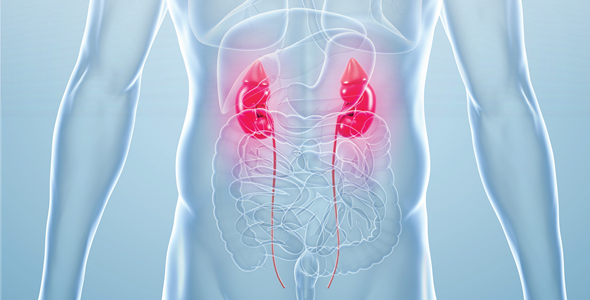By the bioMérieux Connection Editors
Nephrotoxicity occurs when the kidneys are not able to function properly due to damage or destruction. Nephrotoxicity can be caused by environmental pollutants, such as cadmium, mercury, arsenic, and lead, natural substances, including aristolochic acids (found in certain plants) and mycotoxins (found in certain fungi), and numerous drugs, like cancer therapeutics, drugs of abuse, and some antibiotics. Drug-induced nephrotoxicity is a common cause of acute kidney injury (AKI) and is more common in hospitalized patients, particularly those in intensive care. AKI is a serious complication—it is associated with a 3.5-fold increased risk of mortality for hospitalized patients.
If certain antibiotics have the potential to cause nephrotoxicity, why use them at all? In some cases, these drugs may be one of the only ways to treat an infection. Infectious pathogens have evolved over time, and many have developed resistance to their routinely-prescribed antibiotics. To treat these resistant infections, alternate forms of treatment must be administered. Two antibiotics associated with nephrotoxicity that are used to treat dangerous resistant infections are vancomycin and colistin.
Vancomycin: One of Only a Few Treatment Options for MRSA
Vancomycin is frequently used for treating resistant Gram-positive bacterial infections, such as methicillin‐resistant Staphylococcus aureus (MRSA), but has been plagued with concerns about nephrotoxicity since its approval in 1958. It has been exceedingly difficult in studies and practice to prove that vancomycin itself is nephrotoxic, mostly because there are multiple confounding predisposing factors, so proof of causality would require randomized controlled trials. Because randomized drug trials assign therapy to patients by chance, there are ethical concerns surrounding their use in cases where patient lives hang in the balance. As such, most studies on the potential nephrotoxicity of vancomycin have been observational in nature.
A 2019 cohort study of 7,422 hospitalized adults did find that vancomycin trough levels (the lowest concentration of a drug before the next dose is given) are predictive of nephrotoxicity and warned that judicious use is critical in limiting the burden of kidney disease in acutely ill patients. Alternative first-line drugs for treating MRSA include teicoplanin, which has been found to have a lower risk of nephrotoxicity than vancomycin, and daptomycin, which is currently the only antibiotic to have shown noninferiority to vancomycin in the treatment of MRSA. However, these drugs come with their own limitations: teicoplanin is not currently available for use in the US, and daptomycin cannot be used for pneumonia because the pulmonary surfactant (a layer of fats and proteins in the lungs that aids breathing) prevents the drug from working properly. Although pneumonia caused by MRSA is relatively rare, one third of all patients hospitalized for community-acquired pneumonia develop AKI, so this is an important limitation.
MRSA can also be treated with linezolid, ceftaroline, tedizolid, telavancin, dalbavancin, and oritavancin, among other antibiotics. Cost and side-effects such as nephrotoxicity and thrombocytopenia (low blood platelet count) of these antibiotics are significant considerations when evaluating alternatives to vancomycin.
Colistin: The Controversial Antibiotic Makes a Come-Back
Currently, colistin is considered the last-resort antibiotic for many multi-drug resistant bacteria, including vancomycin-resistant enterococci and some Gram-negative organisms like Pseudomonas aeruginosa, Acinetobacter baumannii, and Enterobacteriaceae. Colistin was approved for medical use in the United States in 1970; however, after years of clinical use, its popularity diminished due to reports of significant nephrotoxicity.
Colistin has made a resurgence over the last couple of decades, as Gram-negative bacteria are becoming increasingly resistant to other treatment options. The resistance trend, coupled with the decline of antibiotic drug development, has made colistin a critical treatment option, despite the complications it can cause. Different levels of nephrotoxicity have been reported for colistin, but a nephrotoxic effect as high as 40% has been observed. Nephrotoxicity from colistin is dependent on dose and is reversible in most cases when the drug is discontinued.
Preventing Nephrotoxicity While Treating Resistant Infections
Although vancomycin and colistin may have nephrotoxic side effects, their use in treating resistant infections has been beneficial in the absence of other treatment options. Successful prevention of drug-induced nephrotoxicity and AKI while using these drugs relies on knowledge of pathogenic mechanisms of kidney injury, awareness of patient-related and drug-related risk factors, proper preemptive measures, vigilance, and early intervention.
In many circumstances, clinicians must decide between using nephrotoxic drugs or allowing infections to go untreated, or treated sub-optimally, if a suitable alternative cannot be identified. With increasing antimicrobial resistance, this is one of the most difficult clinical quandaries that critical care physicians face. To make matters more complex, even when physicians can discontinue the offending drug and quickly treat with a different antibiotic, the potential for long-term renal complications remains. Even when AKI is less severe, it may contribute to morbidity and mortality in critically ill patients. Clinicians need to be aware of risks when using nephrotoxic drugs and remain vigilant to prevent complications to the best of their ability.
Opinions expressed in this article are not necessarily those of bioMèrieux, Inc.



